A well-planned flower bed can completely change how the front of your house feels.
When designed with easy-care plants and a smart structure, it adds color, texture, and shape without demanding constant attention. The goal isn’t perfection, it’s a balance between beauty and simplicity.
Low-maintenance flower beds let you enjoy the view without the weekly upkeep.
With the right plant choices, thoughtful placement, and reliable materials, your front yard can stay inviting year-round.
It’s about creating something that fits naturally with your home and your lifestyle.
Before You Start: What “Low-Maintenance” Really Means
Low-maintenance doesn’t mean no effort. It means making choices that simplify care over time.
It’s about understanding how plants grow, what your space offers, and how small design decisions can save hours later.
Choose native or drought-tolerant plants that thrive in your climate. Plan smart layouts that reduce trimming, watering, and replanting.
Use mulch, drip irrigation, and clean edging to keep beds tidy. These simple steps help your garden stay manageable and consistent through every season.
Low-Maintenance Flower Bed Ideas for the Front of Your House
These flower bed ideas balance style with simplicity, helping you keep your front yard beautiful with minimal effort.
Each design focuses on hardy plants, smart layouts, and timeless looks that stay fresh throughout the seasons without constant upkeep.
1. Native Perennial Border Bed
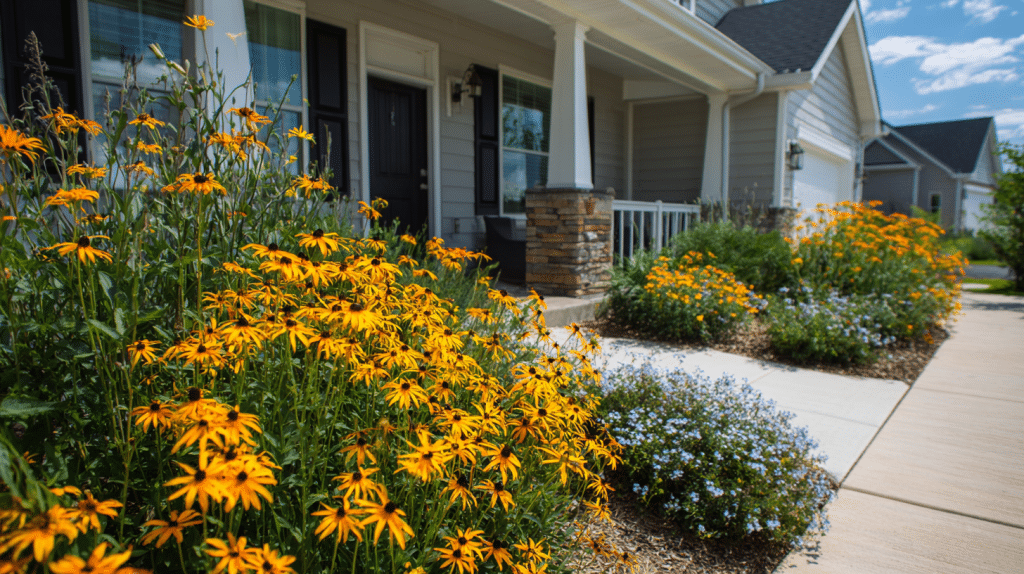
Line the front of your house with native perennials that return yearly. They thrive naturally in your climate, resist pests, and require minimal watering.
Combine hardy favorites like coneflowers, black-eyed Susans, and coreopsis for consistent color and texture through changing seasons.
2. Drought-Tolerant Xeriscape Bed

Reduce watering needs with a xeriscape bed featuring gravel, succulents, and hardy plants like lavender and sedum.
Add smooth river stones or driftwood for structure. This design creates a serene, modern landscape that’s sustainable and elegant in any climate.
3. Raised Flower Bed Along the Foundation
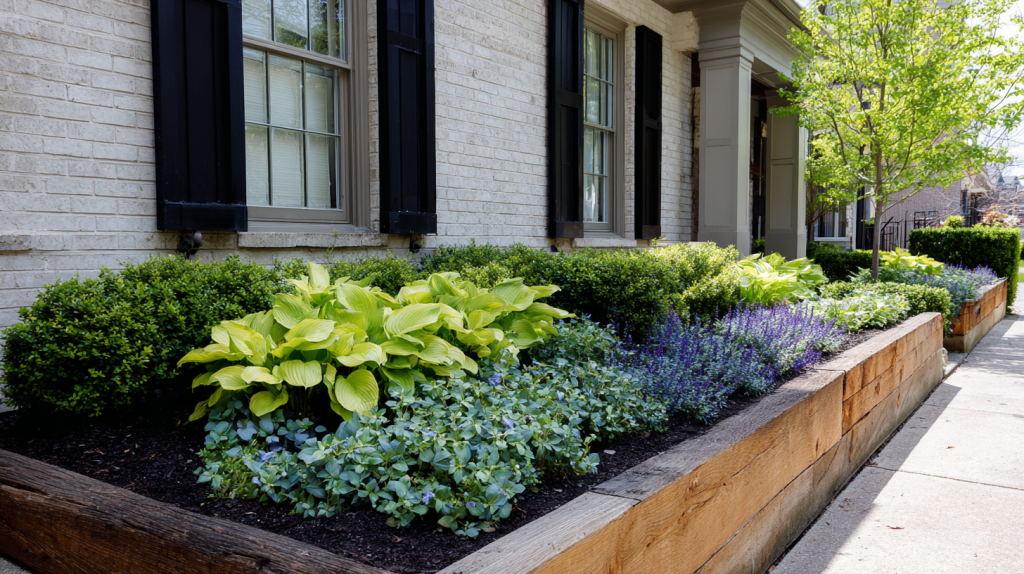
A raised bed helps manage drainage and makes plant care easier. Fill it with compact shrubs and perennials such as hostas, boxwoods, or salvia.
The defined border keeps things tidy while softening the transition between house and yard.
4. Evergreen Shrubs with Year-Round Structure
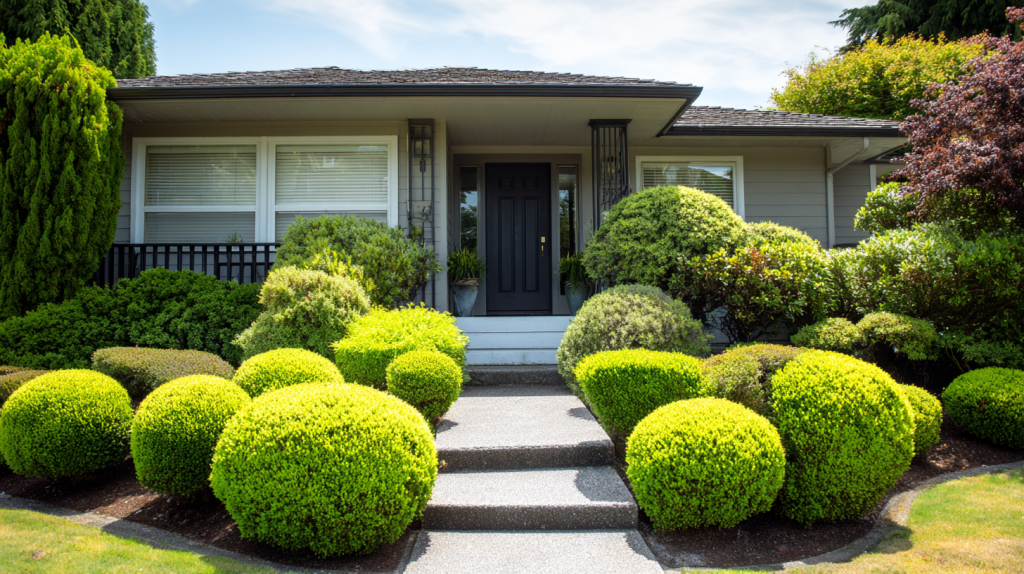
Anchor your front yard with evergreens like boxwood, juniper, or dwarf spruce. They keep their color and shape all year, providing structure even in winter.
Pair with small flowering perennials for subtle seasonal variation that stays effortlessly neat.
5. Ornamental Grasses Mixed with Perennials

Ornamental grasses such as feather reed or fountain grass add motion and soft texture. Mix them with low-care perennials like daylilies or yarrow for balance.
Together, they create a dynamic display that’s attractive and naturally low-maintenance year-round.
6. Groundcover-Only Bed for Weed Control
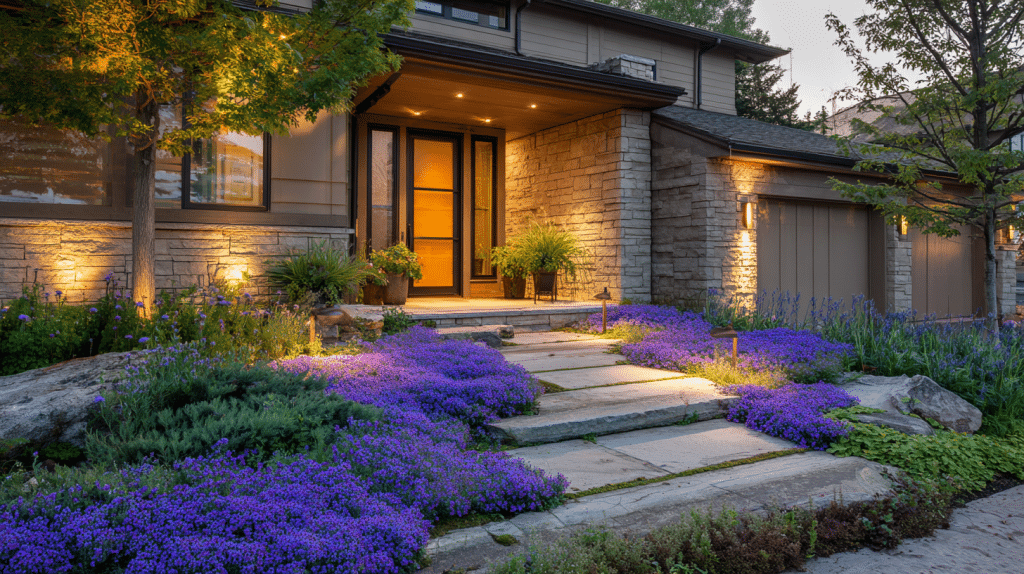
Fill a flower bed entirely with low, spreading plants like creeping thyme or ajuga. Groundcovers blanket the soil, prevent weeds, and reduce watering needs.
Their dense growth gives a clean, uniform look without demanding constant attention or replanting.
7. Simple Symmetrical Beds by the Entryway
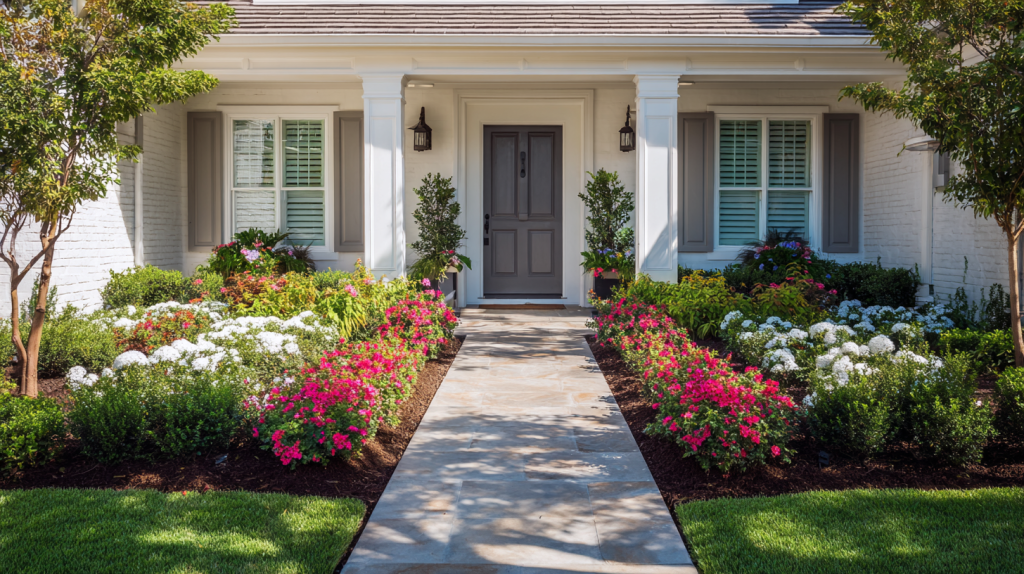
Flanking your doorway with mirrored beds creates a balanced, polished first impression. Use identical shrubs, flowers, or planters on each side.
This simple symmetry feels refined yet requires little upkeep beyond an occasional trim or mulch refresh.
8. Rock Garden with Succulents and Gravel
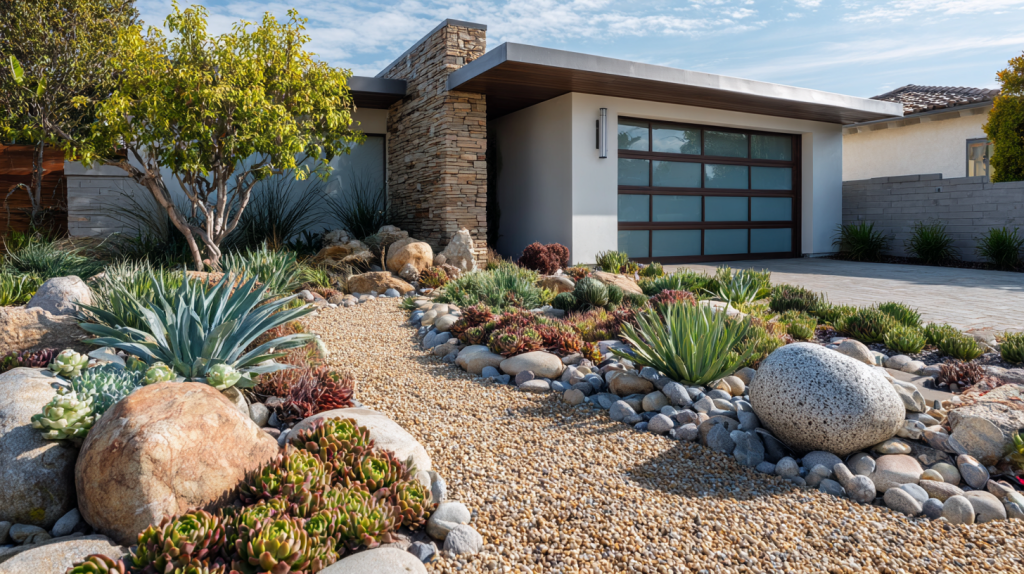
Blend succulents, pebbles, and drought-resistant plants into a rock garden for a sculptural effect. Varieties like echeveria or hens-and-chicks thrive in dry soil.
The contrast between stone and foliage gives texture while keeping maintenance low and watering minimal.
9. Pollinator-Friendly Bed with Wildflowers
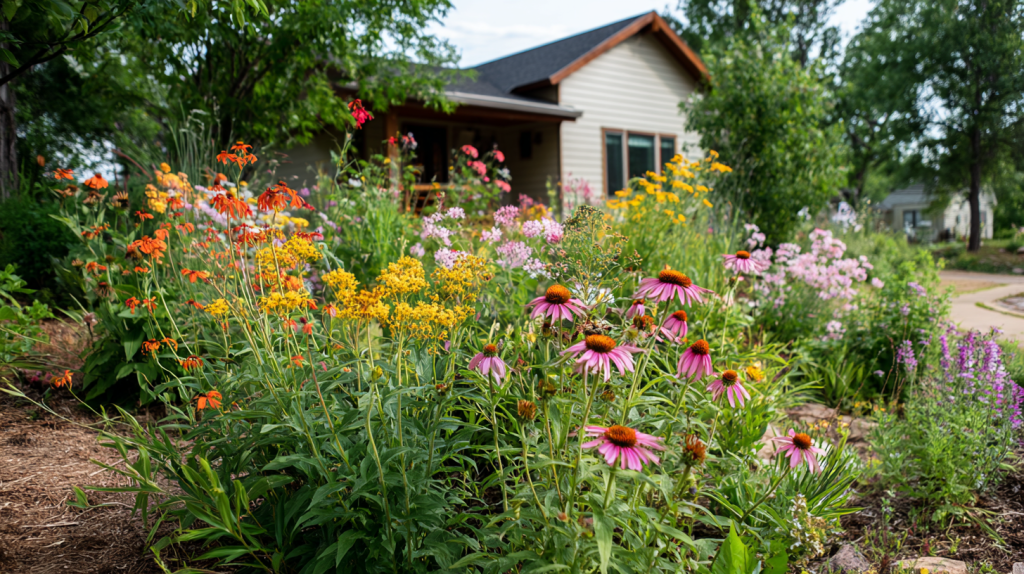
Plant native wildflowers such as bee balm, milkweed, and blanket flower to attract bees and butterflies.
These resilient plants need little care once established and provide colorful blooms all season while supporting pollinators essential to a healthy garden ecosystem.
10. Minimalist Monochrome Bed (All Whites or Greens)
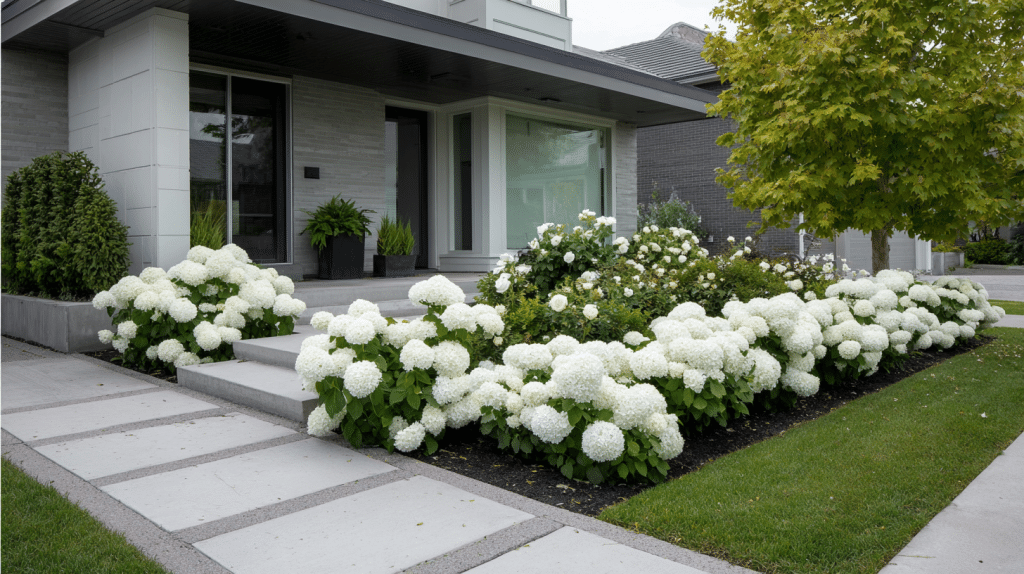
Keep it simple with one color palette, like all-white blooms and soft green foliage. Monochrome beds feel modern and calm, reducing decisions on plant selection.
Choose easy-care varieties like white roses, hydrangeas, or dusty miller for elegance and ease.
11. Cottage-Style Bed with Easy Perennials

Bring charm without the chaos by mixing reliable, low-care flowers like lavender, daisies, and coneflowers. Layer heights for visual depth, and let plants grow naturally.
Cottage-style gardens look abundant yet forgiving, blending structure with relaxed, timeless beauty.
12. Modern Bed with Geometric Edges and Fewer Plants
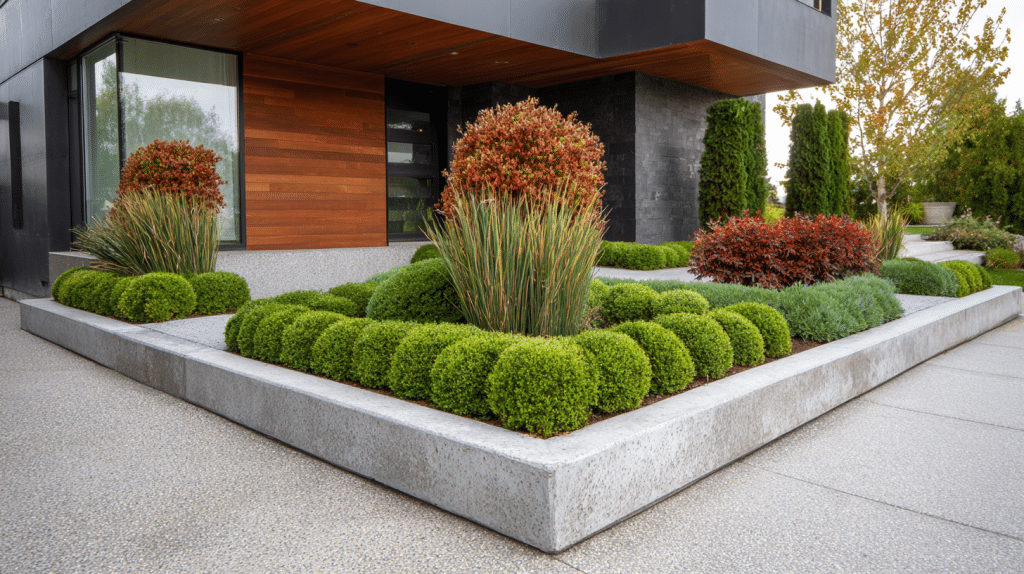
Keep a clean, contemporary feel using strong lines, concrete borders, and minimal plant varieties. Combine structured evergreens with ornamental grasses for balance.
Fewer species mean simpler maintenance and a striking, organized look that complements modern architectural styles.
13. Walkway Border Bed with Low Growers
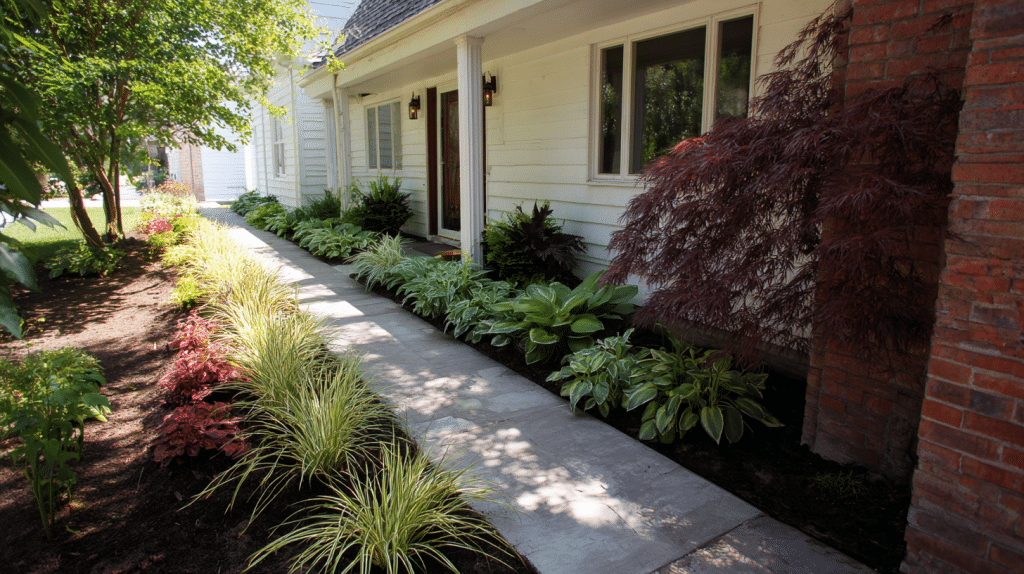
Frame a front walkway with short, neat plants like coral bells, dwarf liriope, or sedum. These low growers stay compact and resist overgrowth.
The result is a tidy, inviting edge that improves curb appeal without constant pruning.
14. Shade-Tolerant Bed Under Trees
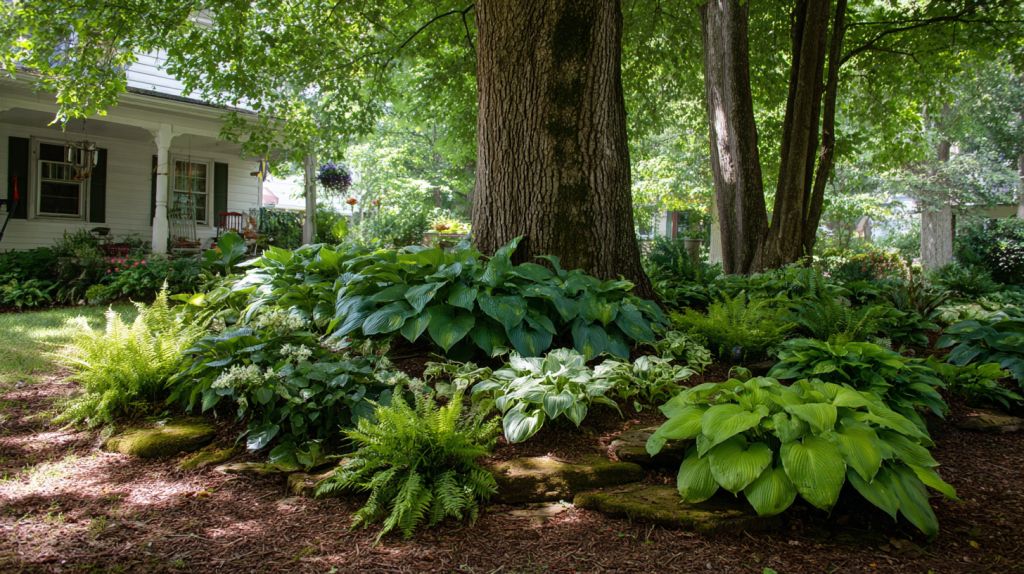
Under large trees, plant shade-loving species such as ferns, hostas, or heucheras. Their lush foliage adds texture and depth in low light.
Add mulch to retain moisture and prevent weeds, creating a calm, natural retreat beneath your canopy.
15. Raised Stone Bed for Height and Definition
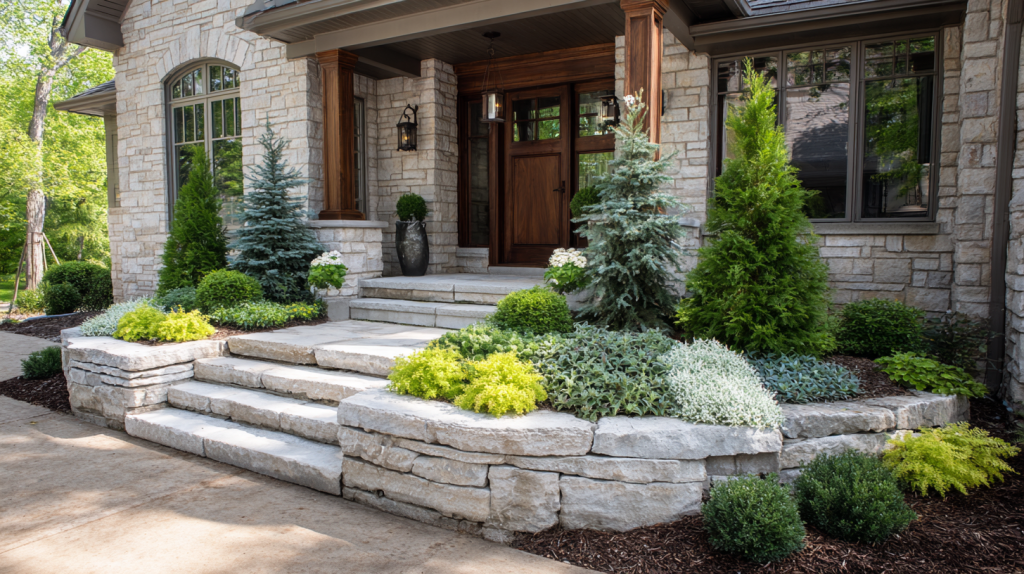
Build a raised stone border to define your garden and improve drainage. Fill it with sturdy perennials and shrubs like sedum, coreopsis, or small evergreens.
The elevation adds visual interest while keeping maintenance simple and contained.
16. Mailbox Bed with Hardy Shrubs and Seasonal Color
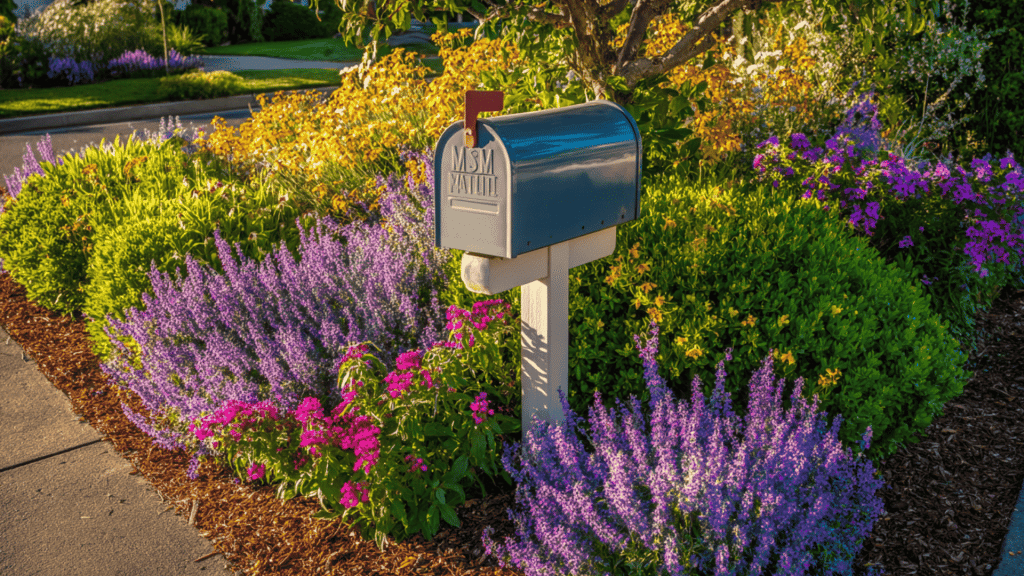
Surround your mailbox with low shrubs and long-blooming flowers such as lantana or salvia. These hardy plants withstand heat and road exposure.
A small ring of mulch keeps weeds out and adds a clean, finished touch.
17. Curved Driveway Bed with Layered Heights

Use a soft, curving shape to break up hard driveway lines. Plant taller shrubs toward the back and shorter perennials in front.
Mixing textures like grasses and blooms keeps the design interesting yet easy to manage.
18. Evergreen + Flower Combo for Year-Round Color
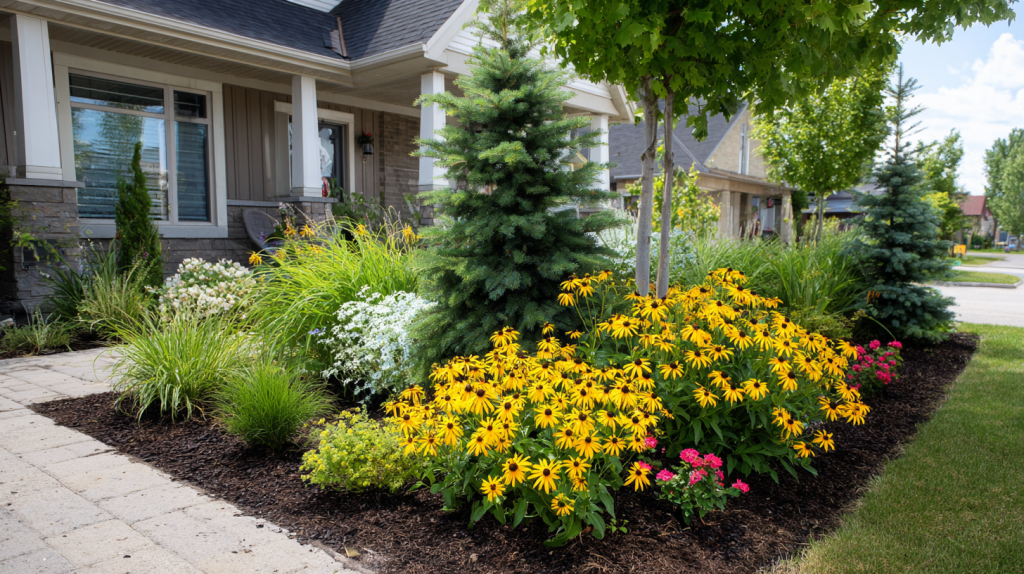
Pair evergreens with bright, low-care perennials such as black-eyed Susans or geraniums. The greenery provides a consistent backdrop while flowers add seasonal charm.
Together, they deliver color and structure throughout the year with minimal work.
19. Container-Integrated Bed (Mix of Pots and Plants)
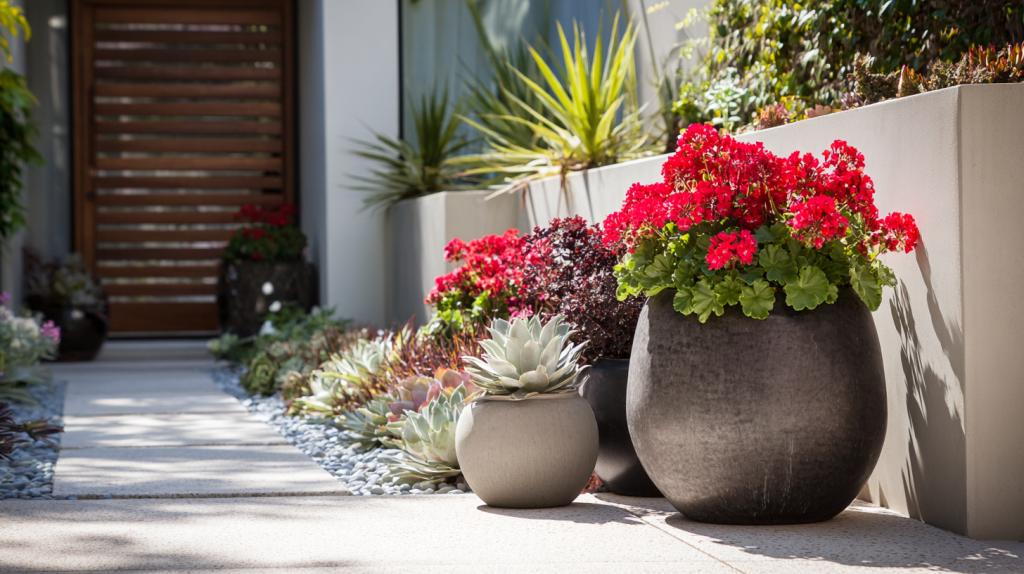
Blend in decorative containers among planted beds for flexibility and variety. Use self-watering pots with simple plants like succulents or geraniums.
Swapping container plants seasonally updates the look without redoing the entire flower bed.
20. Native Grass Bed for Movement and Texture
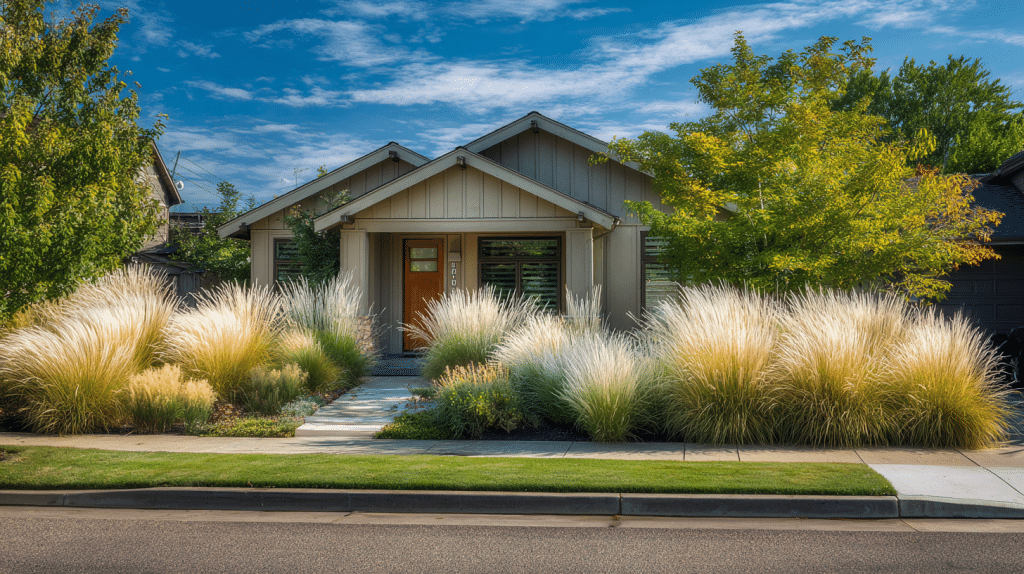
Use hardy native grasses such as switchgrass or little bluestem for soft movement and depth.
These species thrive in varying conditions, resist pests, and require minimal trimming, offering a natural, low-maintenance way to frame your front yard.
21. Minimalist Bed with One Focal Plant and Clean Mulch
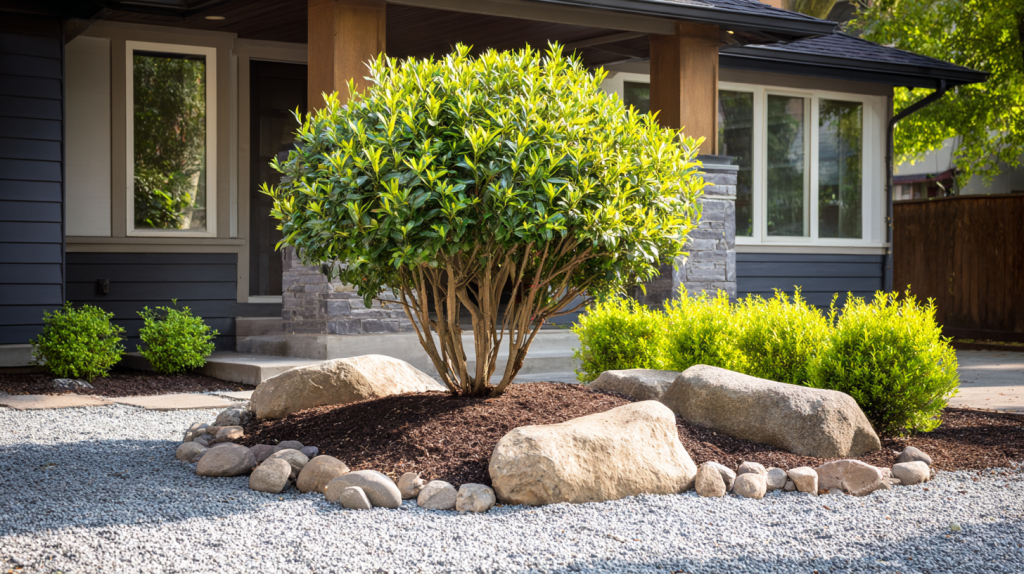
Choose one striking plant, like an ornamental tree or sculptural shrub, as the centerpiece. Surround it with mulch or gravel for simplicity.
This uncluttered design draws attention while staying easy to maintain and visually refined.
22. Compact Bed for Small Front Yards

In limited spaces, select dwarf shrubs and small perennials such as mini boxwoods or dianthus. Their compact form maintains proportion with smaller facades.
A simple layout keeps the yard balanced without overwhelming tight areas.
23. Front-Porch Edge Bed with Drought-Proof Plants
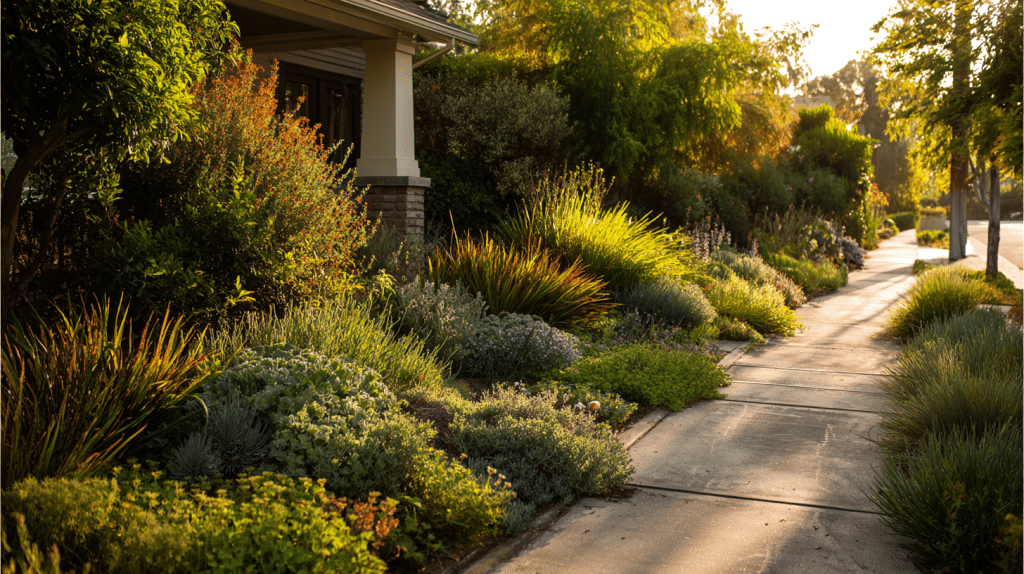
Line your porch with sun-loving, hardy plants like sage, sedum, or lantana. These tolerate heat and need little watering.
The edge planting softens architectural lines while framing the entryway in color and texture year-round.
24. Flower Bed Framing a Feature Tree or Lamp Post

Surround a central feature like a tree or lamp with low-growing blooms or foliage. Plants such as begonias or hostas add softness without hiding the structure.
This creates a cohesive, finished look that’s easy to maintain.
25. Bed with Decorative Gravel and Spot Color Blooms
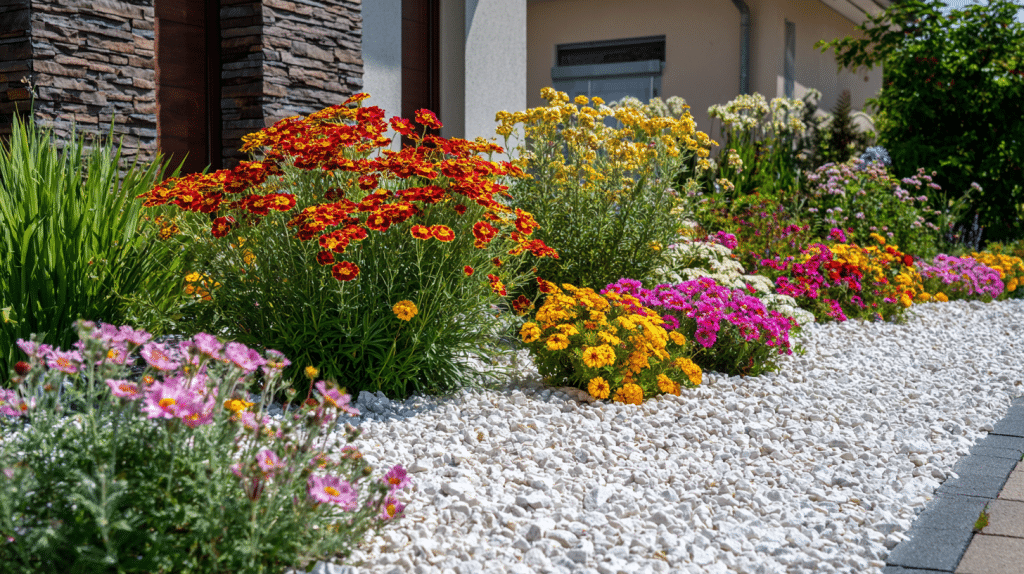
Combine decorative gravel with small clusters of flowering plants for contrast. Hardy options like gaillardia or coreopsis provide bright pops of color against stone.
This design stays tidy and low-maintenance with excellent drainage and minimal watering.
26. Raised Corner Bed with Shrubs and Evergreens
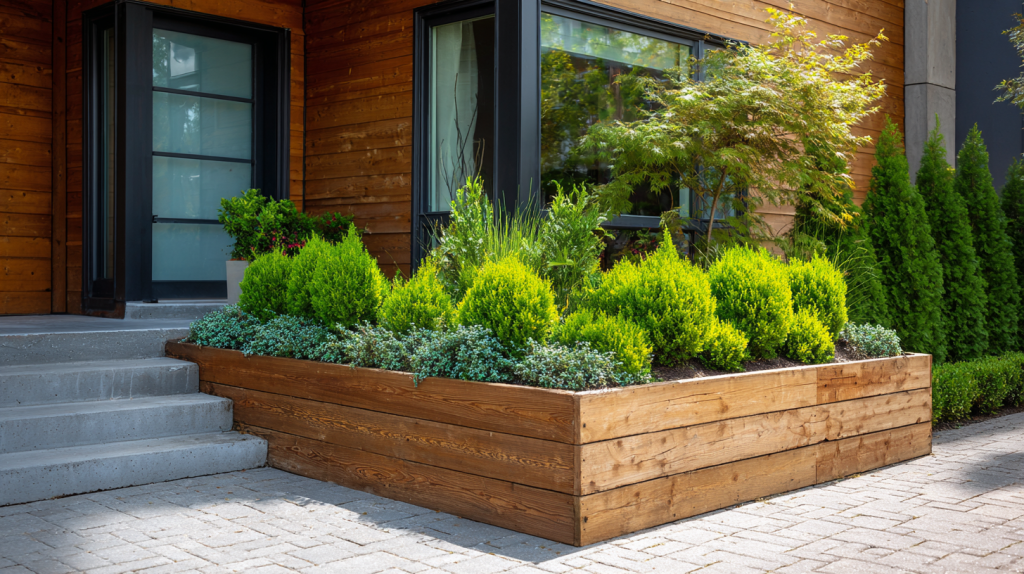
Fill an unused corner with a raised bed built from stone or wood. Plant slow-growing evergreens and compact shrubs for form and texture.
It turns an overlooked space into a low-care focal point year-round.
27. Bed Designed for All-Season Interest
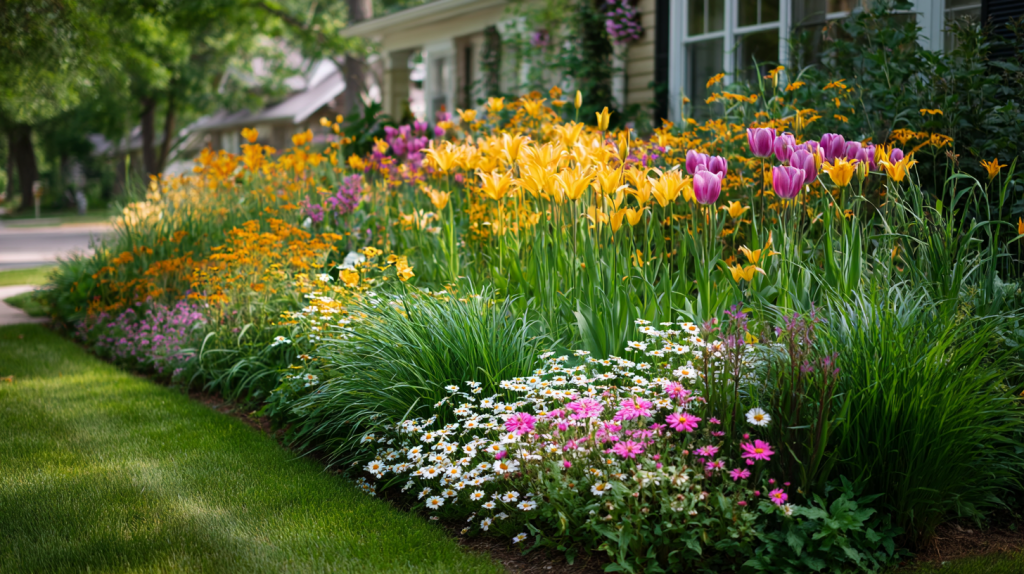
Mix evergreen plants with bulbs and perennials for continuous color. Spring tulips, summer daisies, and fall sedges ensure visual interest.
The variety keeps the landscape appealing throughout the year with minimal replanting required.
28. Modern Coastal Bed with Sand-Tolerant Plants and Pebbles
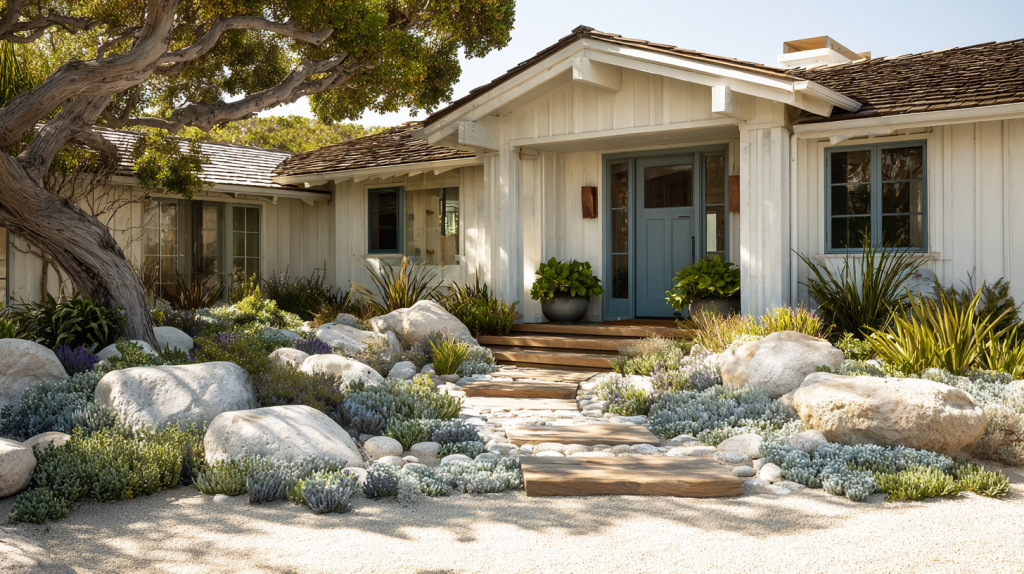
Design a breezy, seaside-inspired look using sand-tolerant plants like sea thrift or blue fescue. Add light-colored pebbles for contrast and texture.
This simple combination stands up well to wind, sun, and salt with little care.
Tips for Making It Truly Low-Maintenance
A few thoughtful habits can make your front yard look cared for year-round without adding to your workload.
- Install drip irrigation with a timer. Automated watering keeps moisture even and efficient without daily effort.
- Refresh mulch once a year. It locks in moisture, blocks weeds, and keeps beds neat.
- Plant in clusters. Grouping similar plants fills gaps quickly and reduces weed growth.
- Use permanent edging. Stone or metal borders prevent grass from creeping into beds.
- Choose compact or slow-growing plants. Smaller shrubs keep their form naturally and reduce trimming.
- Match plants to their environment. Keep sunlight and watering needs consistent for balanced growth.
- Limit variety. A few repeating plants feel intentional and are easier to maintain.
These simple maintenance choices help your flower beds stay healthy, tidy, and consistent through every season.
Conclusion
Low-maintenance landscaping is about designing smart, not working harder. Choosing durable plants, reliable materials, and simple structures can turn your front yard into a space that stays inviting through the year.
With balance and planning, it’s possible to have a garden that thrives quietly on its own.
Start small, adjust as you learn what works, and enjoy the process of watching your space grow into something naturally beautiful.
Which of these flower bed ideas would you try first? Share your favorite in the comments below: your ideas might inspire someone else’s garden.


